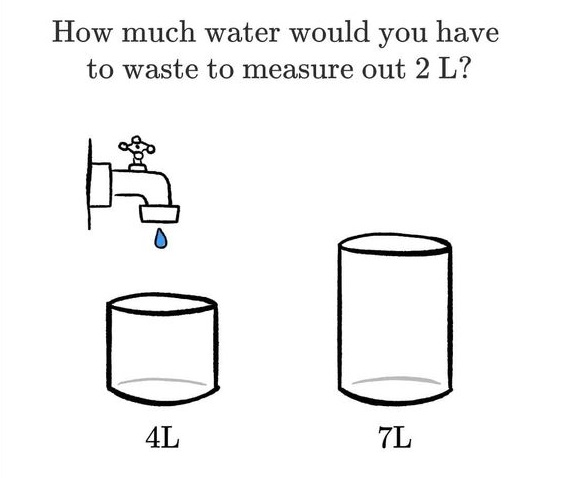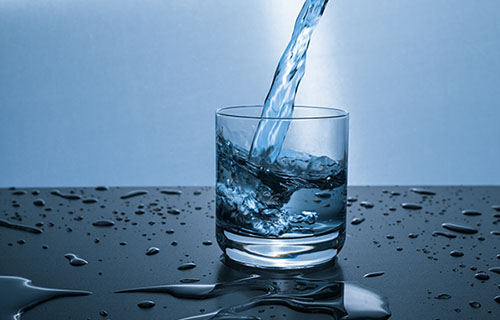Everyone loves a good brain teaser! Today’s puzzle presents a simple yet mind-bending challenge: using only a 4-liter container and a 7-liter container, how can you measure exactly 2 liters of water? It sounds straightforward, but many people get tripped up by the details. Let’s dive into the steps required to solve this classic puzzle and figure out exactly how much water you’ll waste along the way.
Common Mistakes When Solving the Puzzle

Before we start, let’s address some common errors people make with this type of puzzle:
- Assuming It’s Quick and Easy: Many people expect this puzzle to be solved in just a few steps, but it actually takes several precise actions to reach the desired measurement.
- Forgetting About Wasted Water: Since the puzzle asks about the amount of water wasted, it’s essential to track how much is poured out or discarded.
- Eyeballing Instead of Measuring: This puzzle requires exact amounts, so guessing or approximating doesn’t work here. Each container must be filled or emptied with care.
With these common pitfalls in mind, let’s walk through the correct steps to reach our goal.
Step-by-Step Solution: Measuring Out Exactly 2 Liters
To measure out 2 liters using a 4-liter and a 7-liter container, follow these steps closely:
Step 1: Fill the 4-Liter Container
Start by filling the 4-liter container to the top. Now, you have 4 liters of water in this container.
Step 2: Transfer the Water to the 7-Liter Container
Pour all 4 liters from the 4-liter container into the 7-liter container. At this point, the 7-liter container has 4 liters of water, and the 4-liter container is empty.
Step 3: Fill the 4-Liter Container Again
Refill the 4-liter container once more. You now have another 4 liters in the 4-liter container.
Step 4: Top Off the 7-Liter Container
Pour water from the 4-liter container into the 7-liter container until it’s full. Since the 7-liter container already has 4 liters, you’ll only need 3 more liters to fill it. This leaves you with exactly 1 liter in the 4-liter container.
Step 5: Empty the 7-Liter Container (Waste 7 Liters)
Now, empty the 7-liter container to make room for more water. This action wastes 7 liters, so keep track of that.
Step 6: Pour the Remaining 1 Liter into the 7-Liter Container
Take the 1 liter remaining in the 4-liter container and pour it into the now-empty 7-liter container. You now have 1 liter in the 7-liter container.
Step 7: Fill the 4-Liter Container Again
Fill up the 4-liter container again. Now, you’re back to 4 liters in the 4-liter container.
Step 8: Pour the 4 Liters into the 7-Liter Container
Add all 4 liters from the 4-liter container to the 7-liter container. Since the 7-liter container already contains 1 liter, this brings it up to 5 liters. The 4-liter container is now empty again.
Step 9: Refill the 4-Liter Container
Once again, fill the 4-liter container to the top, giving you 4 liters of water.
Step 10: Measure Out the Final 2 Liters
Now, pour water from the 4-liter container into the 7-liter container. The 7-liter container currently holds 5 liters, so you only need to add 2 more liters to fill it completely. This action leaves exactly 2 liters in the 4-liter container.
Congratulations! You now have precisely 2 liters in the 4-liter container.
Calculating the Total Wasted Water

Throughout this process, you needed to empty the 7-liter container twice to make room for additional water. Let’s review the waste:
- First Emptying: Wastes 7 liters (Step 5).
- Second Emptying: Wastes another 7 liters.
In total, you wasted 14 liters of water. It took several steps, but careful tracking and following the process allowed you to measure exactly 2 liters.
Why This Solution Works
This puzzle solution works by repeatedly filling and transferring water between containers with different capacities. Since you can’t measure 2 liters directly, you use the process of elimination—transferring, filling, and emptying water in strategic ways until the 4-liter container holds precisely the amount you need.
Why Puzzles Like This Are So Engaging
Riddles like this one are fantastic for building logical thinking and problem-solving skills. They require you to think beyond first impressions, carefully track resources (in this case, water), and find creative solutions to seemingly simple problems. These puzzles teach you patience and attention to detail, as missing a single step can throw off the entire process.
Conclusion: A Simple Solution That Stumps Many
Measuring exactly 2 liters with a 4-liter and 7-liter container is a classic brain teaser. By breaking it down step-by-step and considering each action carefully, you can see how seemingly impossible tasks often have straightforward solutions. You just need a clear mind and a bit of patience.
So, give this a try on your own or share it with friends to see how they approach it. Who knows? You might even uncover new strategies for solving other everyday puzzles in your life. And remember, the key to success in these challenges is often found in the smallest details.


